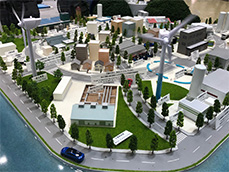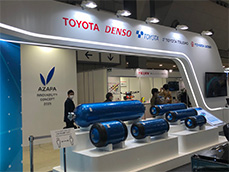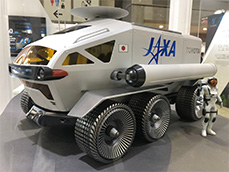Articles for ITS market Will carbon neutrality accelerate the trend to strengthen LCA (Life Cycle Assessment)?
Chairman of Toyoda expresses strong will for LCA.
On March 11, 2021, the day marking the 10th anniversary of the Great East Japan Earthquake, Mr. Akio Toyoda, President of Toyota Motor Corporation joined a press conference of Japan Automobile Manufacturing Association (JAMA). His speech caused a stir in the automobile industry.
In the conference, he introduced of the different activities the automotive industry has conducted in Fukushima, Miyagi and other areas that were severely affected by the disaster over the past 10 years and towards the future.
He also emphasized the importance of LCA, in response to Suga Prime Minister Administration's plan to achieve carbon neutrality by 2050. LCA is the concept of life cycle assessment that evaluates a product over a long period of time, from the extraction of raw materials through to processing, transport, use and disposal.
In view of carbon neutrality in automobiles, the following processes are considered; extraction of crude oil, transportation to Japan, refining and processing into fuel. Also, the raw materials, parts manufacturing, transportation, and final assembly in Japan And then car transportation to dealers and customers, resale as used cars several times, and in some cases, exporting used cars overseas. The LCA must be considered over a long period of time, more than 10 years, until its disposal in foreign countries.
In the past, automakers recognized LCA from the perspective of Corporate Social Responsibility (CSR). While in recent years, attention to ESG investment, which considers environmental, social, and governance factors in addition to the traditional financial status, has grown rapidly together with the importance of LCA.
In respect to this, Mr. Toyoda, as the head of JAMA, indicated that "In order to realize the government's green strategy, it is necessary to develop mobility from renewable energy at an early stage. In order to do so, it is inevitable to review the manufacturing industry on the premise of LCA."
700,000 to 1 million people could lose their jobs.
Mr. Toyoda warned the entire industry that if Japan were to continue with the status quo without actively transforming to green energy. "It will no longer be possible to make cars in Japan"..
He took the Toyota Yaris as an example, saying that if production in Europe emits less CO2 than production in Japan when considering LCA, as a result, the Yaris for the domestic market would be imported from, as an example, France.
Then, in a worst-case scenario, he referred to an estimate by JAMA that 700,000 to 1 million jobs will be affected or lost out of the 5.5 million people involved in automobile related industries in Japan.
Mr. Toyoda also made his annual visit to the Tohoku region in early March 2021. During the visit, he exchanged opinions with local officials at the Fukushima Hydrogen Energy Research Field in Namie Town, Fukushima Prefecture. He expressed his enthusiasm regarding the ambition of achieving a carbon neutral society. "The Automobile industry is right in the middle of carbon neutrality".
Toyota, within the three stages of making, transporting, and utilizing hydrogen, will promote a new business model for the utilization of hydrogen, examples may include the passenger car "MIRAI" and the small fuel cell truck jointly developed with Hino Motors.
In addition, the company intends to implement a CO2 reduction plan based on the LCA concept, including its own plants and those of its suppliers.
What we need is to optimize the "number of cars".
Looking at the announcement by JAMA and Toyota's strategy on hydrogen, it reminds me about one fact, the "number of cars". I think it is important to take a comprehensive perspective on carbon neutrality based on LCA.
The current discussion is only about the conversion of powertrains from gasoline to hybrid type, or to plug-in hybrid vehicles, EVs (electric vehicles), FCVs (fuel cell vehicles), and the implementation of LCA during the manufacturing.
Even if electric vehicles become popular, in order to protect the 5.5 million jobs in Japan's automobile-related industries, the total production volume needs to be maintained at the current level of 5 million units per year. However, the most effective way to achieve carbon neutrality in the transportation equipment sector would be by reducing the volume of production.
The old way of thinking is that if the production shrinks, the balance between market demands will collapse.
Fortunately, recent development on network connectivity and new services such as ridesharing have made it possible to have cars in the right place at the right time.
Even if a passenger car is used for one hour every day, the usage rate is only 4% (1/24 = 0.04).
Ridesharing services, such as Uber and Lyft in the U.S., have expanded rapidly providing more effective use of passenger cars, and the same demand has grown in China and Southeast Asia.
In fact, it is possible to optimize the "number of cars" in society at some level with current technology, which should help to make a proper plan on production.
In reality, cars are sold as a one-time-fee based business. Even with the widespread use of sales methods such as residual value loans, there is no upper limit to the number of vehicles sold. Mass production and mass consumption are still mainstream, "the more vehicles sold the better".
At present, no automaker has indicated when it will shift to an automobile production system based on demand optimization. It is believed that further improvements should be made on business plans in the automobile industry in order to achieve carbon neutrality.
Writer introduction

Mr. Kenji Momota Automotive journalist
His major is the world automotive industry and he is also familiar with the energy industry, IT and the aging society problem as the related fields. He acts around the world based in Japan and USA and writes for the general magazines, the technology journals and the automotive related media etc.
He is also commentator of motor race and world's motor show on TV program based on his career of the driver of Indy Racing League and NASCAR. In recent years, he has been covering about a paradigm shift from developed countries to developing countries, the motorized vehicle like EV and the telematics.
FURUNO ITS Journal
Click here for the latest articles after 2022 (in Japanese)2022
- The "realistic" self-driving roadmap shown by the Japanese government and a hands-on report on the latest Subaru EyeSight X
- Will FCVs (Fuel Cell Vehicles) Become Popular? ~New Movement in Toyota and Honda~
- The 'Complete' online sales of new cars start in Japan. Will this new way of buying cars take root?
- Many Firsts! On-Site Report from Tokyo Auto Salon 2022 - The author, who knows what goes on behind the scenes, looks back on 40 years of history. -
2021
- "Moving toward zero traffic fatalities for four-wheeled and two-wheeled vehicles globally in 2050" ~Experience on Honda's latest safety technologies~
- Tsuneishi Shipbuilding's building and DX, an exclusive visit to the main factory
- Japan's Smart City: New Moves toward Practical Use
- When will self-driving buses (service cars) be put to "full-scale" practical use?
- Utilization vehicle data during disasters
- Toyota-led Connected Technology to Transform Commercial Vehicle Business -From light trucks to large trucks and buses-
- Toyota enters the connected car "Personalization" business
- Japanese automakers' carbon-neutral strategies swept up in ESG investment
- Drive experience of the latest autonomous vehicle models and advanced driving support systems
- Will carbon neutrality accelerate the trend to strengthen LCA (Life Cycle Assessment)?
- Semiconductor shortage exposes realities of the automotive industry
- Online Autonomous Driving Contest Enhancing development of Human Resources
2020
- What happens to CASE when gas cars are banned in Japan?
- When will Flying Cars be launched?
- Expectation vs. reality:Autonomous Driving in Japan
- V2X, Becoming increasingly important in autonomous driving
- Technology of Subaru “EyeSight X”
- Lifestyle-oriented French cars gain popularity in Japan
- Human-oriented smart cities are wanted
- MaaS and CASE, how would automotive industry change after COVID-19?
- The beginning of virtualization era, triggered by COVID-19
- Trend of EV shift and consumer demands
- TOYOTA Press conference about ADAS - Releasing algorithm for "sudden acceleration suppression during attempted sudden acceleration" free of charge -
- The Japanese automotive industry in 2020 - 3 turning points -
- "Using a smartphone while driving" and "Level 3 automated driving"
2019
- Motor show business model is at a turning point - Tokyo Motor Show Report -
- Commercialization and monetization of MaaS - ITS World Congress Singapore Report -
- Android Automotive pays attention to V2X - Report from the Frankfurt Motor Show 2019 in Germany -
- Automobile Distribution Revolution and DCM (Data Communication Module)
- Connected business potential and newly proposed "eMaaS" by Honda
- 5G services for practical use are multiplying
- Connectivity technologies attracting attention due to frequent traffic accidents
- Shanghai Motor Show report -SUV, EV, Automated car & 5G-
- Drone Business roadmap and updates to Michibiki (Quasi-Zenith Satellite System)
- MaaS (Mobility as a Service) "town development." Full-scale promotion for a national project
- CES organizer states "Data Period in 2020s." Transformation of the Automotive Industry in CES, US "-CES2019 Report-"
- "Return to Origin" directed towards the age of change, automatic operation and connectivity
2018
- New proposal for Private Car Automated Driving Level and other Hot 5G Technology Topics
- Standardized EV charging infrastructure concerns in Europe, US, Japan and China - Kobe EVS 31 field report -
- Touring a pure car carrier and a test drive of the latest hybrid car
- Planning stage products are exhibited at the newly established visualized mobility service "TOYOTA MOBILITY SHOWROOM".
- Potential “Community Car-share” program promoted by local residents
- CES Asia Report 2108
- Companies attempt new Vehicle-to-Infrastructure communications, including traffic volume measurements and vehicle positioning. -ITS Asia Pacific Forum in Fukuoka-
- Geneva show in Switzerland. Flying cars and MaaS (Mobility as a Service) were hot topics.
- EV (Electric Vehicle) proposals by country
- MaaS competition through service mobilization, M & A and technical field collaboration is accelerating. - The CES 2018 Report -
2017
- Big data’s initiative and fight for the automotive industry. Cooperation among companies becomes increasingly important.
- Connected car and road-to-vehicle communication automatic operation
- ETC (Electronic Toll Collection) and ETC2.0. Current situation and projected future
- Rapid development of sharing economy
- Germany is first to recognize level 3 automated driving
- ITS EU 2017 Field Reports -Automatic Operation and the eCall-
- From Infotainment to ITS, the competitive area is spreading in the car big data industry.
- GTC (GPU Technology Conference) Report and the de facto standardization of AI (artificial intelligence)
- Renesas' new challenge! "e-AI Solution" and "Renesas Autonomy"
- The Automobile industry is shifting from a manufacturing industry to a service industry.
- The movement toward accident countermeasures for aging drivers in Japan
- Fusion of ride sharing and fully automated driving is advancing in the USA.
2016
- Overview of the Quasi-Zenith Satellite System (QZSS) and advancements toward full-scale practical use including the Tokyo Olympic Games - G-space EXPO 2016 report-
- Japan’s automated driving project "SIP-adus" will be a large demonstration experiment.
- The International Home Care & Rehabilitation Exhibition. There were many car manufactures with exhibits booths at this show.
- Japanese car manufacturers starting to concentrate on strengthening the ADAS system
- A new movement of legislation for autonomous cars
- Cyber Security and “AGL”, the new OS for automotive are hot topics in the connected car industry
- “High precision 3D map” the key future of autonomous car and pedestrian dead reckoning
- Chinese “BAT” is accelerating their business in the EV (Electric Vehicle) market
- Tesla's original connection to Taiwan and the new transportation system technologies.
- "The main topic" of the Geneva Motor Show was how to strengthen "pedestrian protection"
- The probe data business is getting more competitive
- Reporting directly from the 2016 CES show "Data services will soon become the main revenue source of automotive industry"
2015
- Do the automated driving systems need the GNSS (Global Navigation Satellite System) ?
- ETC Version 2.0 is coming soon. A new service was announced at the Tokyo Motor Show and the possibility that is could be used as a device for older drivers.
- "Connected Horizon" and "eHorizon". Germany's leading parts supplier accelerates strengthening of "Big Data" for business



 A model of a community that utilizes renewable energy.
A model of a community that utilizes renewable energy. Fuel cell-related exhibits by Toyota Group companies. Photographed by the author.
Fuel cell-related exhibits by Toyota Group companies. Photographed by the author. A prototype of the “Lunar Cruiser”, a fuel cell-powered lunar vehicle. jointly developed by Toyota and JAXA. Photographed by the author.
A prototype of the “Lunar Cruiser”, a fuel cell-powered lunar vehicle. jointly developed by Toyota and JAXA. Photographed by the author. GPS/GNSS Receiver&Chips and Modules (positioning and timing)
GPS/GNSS Receiver&Chips and Modules (positioning and timing)